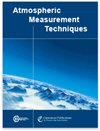Mapping the CO2 total column retrieval performance from shortwave infrared measurements: synthetic impacts of the spectral resolution, signal-to-noise ratio, and spectral band selection
IF 3.3
3区 地球科学
Q2 METEOROLOGY & ATMOSPHERIC SCIENCES
引用次数: 0
Abstract
Abstract. Satellites have been providing spaceborne observations of the total column of CO2 (denoted XCO2) for over two decades now, and, with the need for independent verification of Paris Agreement objectives, many new satellite concepts are currently planned or being studied to complement or extend the instruments that already exist. Depending on whether they are targeting natural and/or anthropogenic fluxes of CO2, the designs of these future concepts vary greatly. The characteristics of their shortwave infrared (SWIR) observations notably explore several orders of magnitude in spectral resolution (from λ/Δλ ∼ 400 for Carbon Mapper to λ/Δλ ∼ 25 000 for MicroCarb) and include different selections of spectral bands (from one to four bands, among which there are the CO2-sensitive 1.6 µm and/or 2.05 µm bands). The very nature of the spaceborne measurements is also explored: for instance, the NanoCarb imaging concept proposes to measure CO2-sensitive truncated interferograms, instead of infrared spectra like other concepts, in order to significantly reduce the instrument size. This study synthetically explores the impact of three different design parameters on the XCO2 retrieval performance obtained through optimal estimation: (1) the spectral resolution, (2) the signal-to-noise ratio (SNR) and (3) the spectral band selection. Similar performance assessments are completed for the exactly defined OCO-2, MicroCarb, Copernicus CO2 Monitoring (CO2M) and NanoCarb concepts. We show that improving the SNR is more efficient than improving the spectral resolution to increase XCO2 precision when perturbing these parameters across 2 orders of magnitude, and we find that a low SNR and/or a low spectral resolution yield XCO2 with vertical sensitivities that give more weight to atmospheric layers close to the surface. The exploration of various spectral band combinations illustrates, especially for lower spectral resolutions, how including an O2-sensitive band helps to increase the optical path length information and how the 2.05 µm CO2-sensitive band contains more geophysical information than the 1.6 µm band. With very different characteristics, MicroCarb shows a CO2 information content that is only slightly higher than that of CO2M, which translates into XCO2 random errors that are lower by a factor ranging from 1.1 to 1.9, depending on the observational situation. The performance of NanoCarb for a single pixel of its imager is comparable to those of concepts that measure spectra at low SNR and low spectral resolution, but, as this novel concept would observe a given target several times during a single overpass, its performance improves when combining all the observations. Overall, the broad range of results obtained through this synthetic XCO2 performance mapping hint at the future intercomparison challenges that the wide variety of upcoming CO2-observing concepts will pose.绘制短波红外测量的二氧化碳总量柱检索性能图:光谱分辨率、信噪比和光谱波段选择的合成影响
摘要。二十多年来,卫星一直在对二氧化碳总气柱(XCO2)进行空间观测,由于需要对《巴黎协定》的目标进行独立验证,目前正在计划或研究许多新的卫星概念,以补充或扩展已有的仪器。根据是否针对二氧化碳的自然和/或人为通量,这些未来概念的设计大相径庭。其短波红外(SWIR)观测的特点主要是在光谱分辨率上探索几个数量级(从碳绘图仪的 λ/Δλ ∼ 400 到 MicroCarb 的 λ/Δλ ∼ 25 000),并包括不同的光谱波段选择(从一个波段到四个波段,其中有对 CO2 敏感的 1.6 µm 和/或 2.05 µm 波段)。此外,还探讨了空间测量的性质:例如,纳米碳成像概念建议测量对二氧化碳敏感的截断干涉图,而不是像其他概念一样测量红外光谱,以大幅缩小仪器尺寸。本研究综合探讨了三个不同设计参数对通过优化估计获得的 XCO2 检索性能的影响:(1) 光谱分辨率,(2) 信噪比 (SNR) 和 (3) 光谱带选择。我们还对精确定义的 OCO-2、MicroCarb、Copernicus CO2 Monitoring (CO2M) 和 NanoCarb 概念进行了类似的性能评估。我们发现,在对这些参数进行两个数量级的扰动时,提高信噪比比提高光谱分辨率更有效地提高 XCO2 的精度,而且我们发现,低信噪比和/或低光谱分辨率产生的 XCO2 垂直灵敏度更重视靠近地表的大气层。对各种光谱波段组合的探索表明,特别是对于较低的光谱分辨率,包括一个对氧气敏感的波段如何有助于增加光路长度信息,以及对二氧化碳敏感的 2.05 µm 波段如何比 1.6 µm 波段包含更多的地球物理信息。MicroCarb 具有非常不同的特性,其二氧化碳信息含量仅略高于 CO2M,这意味着 XCO2 随机误差较低,根据观测情况,误差系数从 1.1 到 1.9 不等。NanoCarb 相机单个像素的性能可与那些在低信噪比和低光谱分辨率下测量光谱的概念相媲美,但是,由于这种新概念会在单次飞越过程中对给定目标进行多次观测,因此在综合所有观测结果时,其性能会有所提高。总之,通过这一合成 XCO2 性能图谱所获得的广泛结果,暗示了即将推出的各种二氧化碳观测概念将在未来带来的相互比较挑战。
本文章由计算机程序翻译,如有差异,请以英文原文为准。
求助全文
约1分钟内获得全文
求助全文
来源期刊

Atmospheric Measurement Techniques
METEOROLOGY & ATMOSPHERIC SCIENCES-
CiteScore
7.10
自引率
18.40%
发文量
331
审稿时长
3 months
期刊介绍:
Atmospheric Measurement Techniques (AMT) is an international scientific journal dedicated to the publication and discussion of advances in remote sensing, in-situ and laboratory measurement techniques for the constituents and properties of the Earth’s atmosphere.
The main subject areas comprise the development, intercomparison and validation of measurement instruments and techniques of data processing and information retrieval for gases, aerosols, and clouds. The manuscript types considered for peer-reviewed publication are research articles, review articles, and commentaries.
 求助内容:
求助内容: 应助结果提醒方式:
应助结果提醒方式:


